| |
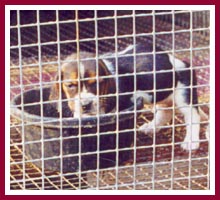 Wisconsin Puppy Mill
Project receives many messages from young people. They are concerned about
puppy mills, and want to help by writing essays and research papers, or doing
class presentations. We enjoy helping these students -- who are tomorrow's pet
guardians, law makers, and informed consumers. Wisconsin Puppy Mill
Project receives many messages from young people. They are concerned about
puppy mills, and want to help by writing essays and research papers, or doing
class presentations. We enjoy helping these students -- who are tomorrow's pet
guardians, law makers, and informed consumers.
Here are many actual
questions from students and our responses. You can browse by topic, using the
links below, or just scroll down through the entire list. Your question might
be answered here already.
After reading these,
if you have any other questions, or if something is confusing, please feel free
to email us. Good luck
with your project, and thank you for helping us "get the word out"
about puppy mills!
|
| |
|
|
| |
| |
 Wisconsin Puppy Mill's Position on Puppy Mills Wisconsin Puppy Mill's Position on Puppy Mills
1. What is your position on puppy mills?
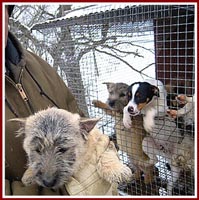 Wisconsin Puppy Mill
Project is dedicated to public education about Wisconsin puppy mills and ending
the suffering of mill animals. Wisconsin Puppy Mill
Project is dedicated to public education about Wisconsin puppy mills and ending
the suffering of mill animals.
Simply put, we don't
feel that pets should be bred and raised like livestock. It's bad for the pets,
bad for the parents, and bad for the unsuspecting people who buy them expecting
a healthy, happy pet.
2. What steps does the Wisconsin Puppy Mill
Project take in fighting puppy mills?
We have been working
on legislation, providing relief to mill animals, and educating the public
about commercial breeding facilities since 1998.
We attend events,
give lectures and presentations, and have hosted Round Table discussions with
legislators, lobbied legislators in Madison and Washington DC. We've
distributed materials like bumper stickers and
tee shirts to help spread public awareness. We circulated a
petition that was presented to our state
legislators. We attended protests of the Thorp
Dog Auction and pet shops that sell puppy mill puppies.
On 1 December 2009,
our 12-year-long dream came true, as, with his signature, Governor Doyle turned
AB-250, the Dog Breeders Licensure Bill, into the ground-breaking Commercial
Dog Breeders Licensure Law, now known as Wisconsin Act
90.
That was just the
first step -- throughout 2010 and the beginning of 2011, the Wisconsin Puppy
Mill Project was instrumental in formulating and gathering public support for
ATCP 16, the Administrative Rules to enforce the new law.
Act
90/ATCP 16 went into effect on 1 June 2011.
The Wisconsin Puppy
Mill Project also reaches people all over the world with our extensive website,
has helped writers in the US and abroad with magazine articles, and answers
many, many questions via email.
3. In your opinion, do you think enough people in
today's society know about puppy mills?
NO!
That's why it's important that young people write reports to help tell people
where those cute pet store puppies come from! The more people who know what is
going on, the more outcry there will be to stop it, and the more people who
will actively work to end puppy mills -- even if it's just to stop buying pets
from pet stores, flea markets, classified ads, and over the internet, and
instead adopt from shelters.
To make it easier for
others to help get the word out, we have "printer friendly" flyers, signs, and
brochures that people can download from our website, print, and hand out.
|
| |
Top
|
| |
 Puppy
Mill History Puppy
Mill History
1. How/When did puppy mills get started?
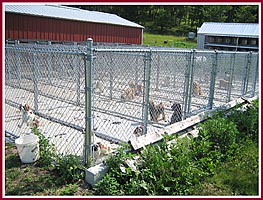 Puppy mills started
right after World War II (1946 or thereabouts). When farmers' crops were
failing, they needed to find another way to make money, so they started raising
puppies -- whether they knew anything about taking care of dogs or not. Dogs
were housed in whatever buildings were available, including barns, sheds,
chicken coops, and rabbit hutches! To many "puppy farmers," the
parent dogs were livestock, like their hogs or chickens or cows, and the
puppies were just another "cash crop." Puppy mills started
right after World War II (1946 or thereabouts). When farmers' crops were
failing, they needed to find another way to make money, so they started raising
puppies -- whether they knew anything about taking care of dogs or not. Dogs
were housed in whatever buildings were available, including barns, sheds,
chicken coops, and rabbit hutches! To many "puppy farmers," the
parent dogs were livestock, like their hogs or chickens or cows, and the
puppies were just another "cash crop."
Farming puppies
started in the midwest, but as the number of pet stores grew, so did the number
of "puppy farms" to keep up with the demand.
For a little more detail on the
history of puppy mills, please see:
|
| |
Top
|
| |
 Puppy
Mill Locations Puppy
Mill Locations
1. Where are puppy mills located, and where are
they most popular?
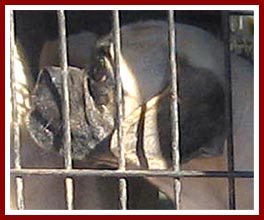 According to the
Humane Society of the United States, thousands of "puppy farms" exist
-- the number is probably actually in the tens of thousands. The seven states
with the most puppy mills are Arkansas, Iowa, Kansas, Missouri, Nebraska,
Oklahoma, and Pennsylvania -- but they can be found in every state in the
United States, and in some foreign countries According to the
Humane Society of the United States, thousands of "puppy farms" exist
-- the number is probably actually in the tens of thousands. The seven states
with the most puppy mills are Arkansas, Iowa, Kansas, Missouri, Nebraska,
Oklahoma, and Pennsylvania -- but they can be found in every state in the
United States, and in some foreign countries
.We are finding that
puppymillers are now moving from states with increasing regulation to states
with no regulation.
2. Which other countries run puppy mill
facilities?
Many countries
outside the US now have puppy mills. These include: Canada, Ireland, Russia and
other eastern European nations, and many countries in South America and Asia.
According to Wayne
Pacelle, President of the Humane Society of the United States, puppies from
China, eastern Europe, Russia, South America, Mexico, and South Korea were
being sold in the United States until very recently! However, on 15 August 2014, the USDA
announced a revised and
updated rule under the Animal Welfare Act to help crack down on the import of
puppies from foreign puppy mills. In brief, the new rule requires that puppies
be at least 6 months of age, have veterinary certificates from their country of
origin attesting to their good health, AND be vaccinated for rabies, distemper,
hepatitis, leptospirosis, parvovirus, and parainfluenza virus (DHLPP) "at
a frequency that provides continuous protection of the dog from those diseases
and is in accordance with currently accepted practices as cited in veterinary
medicine reference guides."
See USDA Closes Another Loophole: New Regs for Import of Foreign Puppy Mill
Puppies for more details, and
read the final rule, USDA Animal Welfare; Importation of Live
Dogs here
|
| |
Top
|
| |
| |
 Puppy
Mills in Wisconsin Puppy
Mills in Wisconsin
1. Is there an exact number of puppy mills in the
state of Wisconsin?
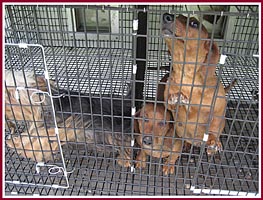 This is a tough
question, because basically there are two kinds of puppy mills: those who sell
wholesale to pet stores or laboratories, and those who sell directly to the
public through classified ads, over the internet, at flea markets, etc. This is a tough
question, because basically there are two kinds of puppy mills: those who sell
wholesale to pet stores or laboratories, and those who sell directly to the
public through classified ads, over the internet, at flea markets, etc.
The breeders who sell
wholesale to pet stores must be licensed by the United States Department of
Agriculture (USDA). The USDA does have minimum standards that the puppy farmers
are supposed to meet. You can read more about the USDA Animal Welfare Act (AWA)
in the USDA
Regulations section of our Existing Laws page. Here, you will also find
links to the USDA website if you would like to read the AWA in its entirety.
In 2008, there were
between 60 - 70 breeders registered with the USDA to sell puppies wholesale in
the state of Wisconsin.
You can see the 2008 list here. The list is alphabetical,
so you'll have to scroll down nearly to the end. NOTE: The USDA no longer puts
these lists on their website. You must file a Freedom of Information Act (FOIA)
request through their website for this information.
By far, the largest
number of puppymillers do NOT sell puppies to pet stores. They sell directly to
the public at swap meets, through ads in the newspapers, over the internet, out
of their cars in shopping plaza parking lots, directly from their farms or
homes, etc.Until 2013, these were not regulated by the USDA. We estimate their
number to be over 2,000.
NOTE: On 10 September 2013,
the USDA announced
a revised and updated definition of “retail pet store” under the
Animal Welfare Act to help ensure the health and humane treatment of pet
animals sold sight unseen via phone, internet, and mail!
For
more information, please see: Internet-based Puppy Mills now Subject to USDA
Regulation!
As of 2008,
we estimated that around 100 commercial breeders licensed as
"Class A" or "Class B" with the USDA were operating in WI,
and over 2,000 unlicensed and unregulated!
NOTE: this number is changing and will change further as the
new Dog Seller Law is enforced. Many commercial breeders are already opting to
go out of business rathar than comply with inspection and
licensing.
As the licensing
process progresses, the Wisconsin Department of Agriculture, Trade, and
Consumer Protection will make the list of licensees available on their website.
However, since rescues and shelters are also
required to be licensed, not ALL of the licensees listed are
puppymills! When this list becomes available, we will add a link
to it.
2. Do you know of the largest one(s) in WI and
where they are located?
Yes, there are
over 20 large mills running in Clark County. There is one large mill running in
Sheboygan County. One very large mill in Green Lake County was recently closed
by the miller selling off to Wisconsin Humane Society in Milwaukee (see
Wisconsin Humane Society Buys Puppy Haven Dogs and Breeding
Equipment for details). There are hundreds of other large mills running in
other parts of the state.
To get a really good
idea about what a typical Wisconsin Puppy Mill is like, see:
Inside A WI "Puppy Farm".
4. Do you know approximately how many dogs are at
the largest puppy mill(s) in Wisconsin?
We have documented as
many as 2,100 dogs (adults and puppies) in one mill alone. Most of the larger
ones have an average of 200-400 dogs at any given time. Remember, the majority
of adult (parent) dogs live in these mills all their lives!
|
| |
Top
|
| |
 Dog
Breeds in Mills Dog
Breeds in Mills
1. Which breeds of dogs do you most commonly see
in puppy mills?
 This varies. If a
breed is popular for some reason, the mills turn out as many as they can, as
fast as they can. Breeds that win prestigious dog shows, such as Westminster,
become very popular. So do those featured in tv shows and movies. This varies. If a
breed is popular for some reason, the mills turn out as many as they can, as
fast as they can. Breeds that win prestigious dog shows, such as Westminster,
become very popular. So do those featured in tv shows and movies.
In general, puppy
millers prefer smaller breeds. Small breeds are always popular and sell easily.
Smaller dogs don't take up as much room so you can fit more into a given space.
They also don't eat as much, so food costs are lower.
West Highland
terriers, Boston terriers, cairn terriers, shih-tzus, bichons, poodles,
Yorkshire terriers, and chihuahuas are always popular. French bulldogs were
very popular in past years, and some millers are raising beagles in quantity
this year.
Larger dogs include
labrador retrievers, akitas, boxers, etc. A Michigan puppy miller who was just
arrested was raising dobermans, rottweilers, and other breeds.
A new trend is toward
so-called "hybrid" breeds such as "puggles" (pug-beagles),
"doodles" (crosses of labrador retrievers, golden retrievers, etc.
with poodles), "schnoodles" (schnauzer-poodle), and the
"poos" (cockapoo, shitz-apoo, yorkiepoo, etc.). There are many, many
more imaginative "hybrids" being bred -- some, with parents that are
already a mix of two or more breeds. Millers are creating their own
"designer breeds" and "breed registries" to go with these
mixed breed puppies.
People see these
"rare" breeds in pet stores or on the internet, think they are cute,
and are willing to pay a lot of money for them.
2. Are dogs the only types of animals that come
from mills?
NO-- For the most
part, ALL animals that are sold in pet stores (including kittens, birds,
rabbits, hamsters, lizards, etc.) come from a "mill" of one sort or
another.
|
| |
Top
|
| |
 Living Conditions in Puppy Mills Living Conditions in Puppy Mills
1. What care do they give the puppies at puppy
mills?
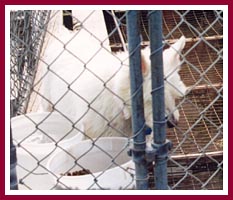 This depends on the
breeder. Some puppies are relatively well cared for in the sense that they are
kept clean and have basic vet care (for shots, tail docking, etc.). In general,
though, puppies get just enough care to keep them alive so that they can be
sold. Some breeders cut off tails and dew claws themselves with kitchen or
garden shears to save on vet costs. Many puppies may never have seen a vet, may
not have had enough to eat, probably lived in filthy cages, and may never have
known a friendly human hand just petting them. This depends on the
breeder. Some puppies are relatively well cared for in the sense that they are
kept clean and have basic vet care (for shots, tail docking, etc.). In general,
though, puppies get just enough care to keep them alive so that they can be
sold. Some breeders cut off tails and dew claws themselves with kitchen or
garden shears to save on vet costs. Many puppies may never have seen a vet, may
not have had enough to eat, probably lived in filthy cages, and may never have
known a friendly human hand just petting them.
2. What are the living conditions in puppy mills?
The puppy millers who
sell to pet stores must be licensed by the United States Department of Agriculture
(USDA). The USDA does have minimum standards that the puppy farmers are
supposed to meet. However, there are many, many puppy millers and just over 100
USDA inspectors for the entire United States. Many times, the puppy millers can
break the rules and not get caught.
Remember, the largest
number of puppymillers do NOT sell puppies to pet stores. They sell directly to
the public at swap meets, through ads in the newspapers, over the internet, out
of their cars in shopping plaza parking lots, directly from their farms or
homes, etc. Here in Wisconsin, there is absolutely NO regulation or licensing
required.
The puppies may be
sick, undernourished, filthy, and injured, but it is the adult dogs who suffer
the most. If a puppy is born with an obvious defect and can't be sold to a pet
store, directly to the public, or to a laboratory, chances are excellent that
it will spend its entire life in the same mill, or be sold to another mill, as
a breeder.
Many puppy mill
breeder dogs live their entire lives on wire mesh in small cages which aren't
cleaned anywhere near often enough. Others are in outside pens, on bare dirt.
They are fed cheap food and as little as possible. They frequently don't have
fresh water available; sometimes, they are forced to drink from water bottles
such as are used in rabbit cages.
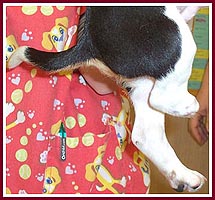 They may be blind or have
legs missing; they may have genetic defects that are being passed along to the
puppies (such as heart murmurs, knee or hip problems, deafness, etc.). They
have rotten teeth and infected mouths from the poor food. They are never taken
out of the cages except to breed, and have none of the pleasant interaction
with humans that we take for granted with our own pets (such as being talked to
in an affectionate tone of voice, petted, played with, or exercised). They may be blind or have
legs missing; they may have genetic defects that are being passed along to the
puppies (such as heart murmurs, knee or hip problems, deafness, etc.). They
have rotten teeth and infected mouths from the poor food. They are never taken
out of the cages except to breed, and have none of the pleasant interaction
with humans that we take for granted with our own pets (such as being talked to
in an affectionate tone of voice, petted, played with, or exercised).
When they do see
humans, they are treated very roughly, grabbed by the scruff of the neck, hit,
kicked, etc. In some mills, cages are stacked two and three high. With those
wire mesh floors, you can imagine what life is like for the ones on the bottom,
since they are never removed from the cages to go to the bathroom.
Even worse, some dogs
are housed in open pens outside all year round, in winter and summer, snow and
heat and rain, with little in the way of shelter. No warm beds or blankets.
Sometimes, many dogs
are put together in one cage, and they don't always get along. The more
dominate dogs will get more of the food, and may also bite and injure the other
dogs. In many mills, vet care for the adult dogs is nonexistant -- some millers
"debark" the dogs themselves, very inhumanely. If a mother dog has
problems whelping her pups, the millers may perform their own
"cesarians" with a kitchen or pocket knife. Puppy mill "breeding
stock" may have several types of cancer due to having been bred
constantly. When they are no longer useful to the breeder, they may be shot,
beaten to death, abandoned, or worse.
The smell is
horrible; there can be flies and bugs and rodents. Many are "tagged"
with cattle tags on rusty chains around and sometimes inbedded into their
necks, and at least one mill punched the tags through the dogs' ears just as
they did with their cows.
The worst part is,
many puppy millers don't see that they are doing anything wrong. To them, the
dogs are "livestock," just as chickens, cows, and rabbits are. They
can't understand why people would actually bring a dog into the house!
3. How do they keep track of all the puppies at
the puppy mill? (such as new births, ages, etc.)
 Farmers generally
keep good records on their "livestock." The parent dogs are often
given numbers. The numbers may be on their cages, or on tags either hung on
chains around their necks, or punched through their ears (like the ear tags on
cattle). The parent dogs probably never know names like pet dogs do. The
farmers keep records of when each mother dog has puppies. Farmers generally
keep good records on their "livestock." The parent dogs are often
given numbers. The numbers may be on their cages, or on tags either hung on
chains around their necks, or punched through their ears (like the ear tags on
cattle). The parent dogs probably never know names like pet dogs do. The
farmers keep records of when each mother dog has puppies.
The USDA has rules on
how breeders who are licensed with them should identify their dogs.
You can read them here. At the top of that
same web page, you can read the story of Little Tag 19
to see how one "puppy farmer" marked his "breeding stock."
4. How many puppies die a year in the United
States at puppy mills?
I don't think anyone
can answer that for sure. I would guess, given the number of puppy mills and
the number of puppies born every year (estimated by the Humane Society of the
United States to be two to four MILLION) that the number of puppies and adult
dogs that die would be in the thousands -- but that would be just a guess.
5. What do the owners of the puppy mills do with
the puppies that pass away?
In general--Some are
buried, some go to landfills (dumps), some are cremated. Sad to say, some are
put in the compost heap or go to dealers who dispose of dead animals.
|
| |
Top
|
| |
 Puppy
Mill Inspections Puppy
Mill Inspections
1. Who inspects breeding facilities and how does
one measure any problems at the facility?
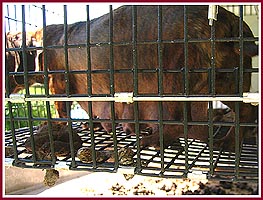 As mentioned above,
in most states , NOBODY inspects the majority of breeding facilities, as they
sell puppies directly to the public and are therefore not subject to federal
regulation. In some states, there are humane and zoning laws in effect, but
inspections are rare unless there is a complaint. As mentioned above,
in most states , NOBODY inspects the majority of breeding facilities, as they
sell puppies directly to the public and are therefore not subject to federal
regulation. In some states, there are humane and zoning laws in effect, but
inspections are rare unless there is a complaint.
The USDA regional
inspector is responsible for keeping tabs on the USDA-registered facilities
(remember, these are only the ones who sell wholesale to pet stores, etc.)
You
can read more about the USDA Animal Welfare Act regulations here. Part 3,
Subpart A deals with Specifications for the Humane Handling, Care, Treatment,
and Transportation of Dogs and Cats.
Another good resource
for further information on exactly what the AWA covers and what inspectors look
for can be found on the
AWA Animal Welfare Publications and Reports page. Some
links to factsheets with overall information can be found here, and if you
scroll down nearly to the bottom of the page, you will find the Inspection
Guides and Manuals section, which has links to the Policy Manual and various
sections on what inspectors are to look for in each licensing category.
Please note that for
over 9,000 licensed facilities (including breeders, dealers, transporters, and
various types of research facilitie) nationwide, there are only about 100
inspectors!
Here in Wisconsin, thanks to Act 90, the Wisconsin Department
of Agriculture, Trade, and Consumer Protection inspects and licenses all dog
sellers and shelters who sell/adopt more than 25 dogs per year from more than 3
litters.
You can read more about DATCP, licensing and inspections in WI,
and the new regulations here.
|
| |
Top
|
| |
| |
 Health Problems of Mill Puppies/Dogs Health Problems of Mill Puppies/Dogs
1. What kinds of problems are dogs prone to when
they come from puppy mills / What are the most common diseases that they
develop or are born with?
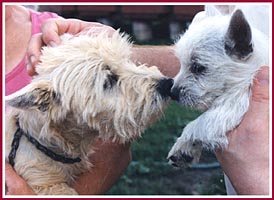 Common problems of
puppies born in puppy mills are: parvovirus, intestinal worms, kennel cough
which can progress into pneumonia, skin problems including mange, giardia (a
gastro-intestinal infection), distemper. Common problems of
puppies born in puppy mills are: parvovirus, intestinal worms, kennel cough
which can progress into pneumonia, skin problems including mange, giardia (a
gastro-intestinal infection), distemper.
Also, puppy mill
puppies can suffer from a number of hereditary conditions such as deafness,
heart murmurs, knee and hip problems, eye problems, kidney problems, thyroid
conditions, seizure disorders, neurological conditions -- and many, many more,
caused by poor breeding practices
They can also show
temperament problems such as aggression (biting for no reason) and may not know
how to act with people or in a home because they have never been held and
petted or even have been inside!
Frequently, puppies
who cannot be sold because of genetic or health problems are kept as breeders
-- dogs with heart problems, seizure disorders, etc. The parent dogs who live
in the mills can be blind, deaf, missing legs, generally have very bad teeth
and mouth infections, plus all of the above -- puppymillers don't waste money
on vets; when the parent dogs are sick or can't have any more puppies, they are
killed or disposed of.
You can read about
some of the problems documented in puppymill dogs that were bought at a
Wisconsin dog auction here. You might
also be interested in our Puppy Mill Survivors:
Caring for Rescued Mill Dogs page.
|
| |
Top
|
 Puppy
Mills and Pet Stores Puppy
Mills and Pet Stores
1. Do ALL puppy millers sell dogs to pet
stores?
 NO! Only a small
percentage of "commercial pet breeders" sell to pet stores. The
majority -- thousands -- sell directly to people over the internet, through ads
in newspapers, at flea markets, etc. NO! Only a small
percentage of "commercial pet breeders" sell to pet stores. The
majority -- thousands -- sell directly to people over the internet, through ads
in newspapers, at flea markets, etc.
2. What number/percentage of dogs in pet stores
come from puppy mills?
I do not know of any
pet stores selling live animals that do not buy MOST of them from mills of one
sort or another. Some pet stores do occasionally buy animals locally, and a
very few are from well-meaning small breeders who don't realize the dangers
facing their puppies by selling them through pet stores.
In November 2008, the
Humane Society of the United States released the results of an eight-month
investigation into one large pet store chain. This study proved conclusively
that, though representatives of the chain denied it, puppies in their stores
came from puppy mills.
3. Why do pet stores get their puppies from puppy
mills?
Most pet stores get
puppies from puppymills for two reasons:
Responsible breeders do NOT sell puppies through brokers
or pet stores; they are proud of their puppies and want to make sure that they
go to the best possible homes. They want to meet the people buying their
puppies, they ask questions and conduct interviews, and if they do not think
the prospective customer will give their pups a good home, they say NO. Pet
stores, on the other hand, will sell an animal to anyone who has the money.
Responsible breeders cannot produce enough puppies to
stock all the pet stores. The commercial volume breeders (aka puppymillers)
feel that they are necessary to breed all the puppies that people want, at a
low enough price that pet store owners can sell them and still make a profit.
4. How do the puppies get from the puppy miller
to the pet stores?
Generally, they are
sold to brokers or dealers, who put them in huge semi trucks (kind of like
moving vans) and truck them around the country to the pet stores. You could
pass one of these trucks on the highway and never even know it was filled with
puppies!
|
| |
Top
|
| |
 In
Our Experience.... In
Our Experience....
1. How many dogs that you have seen or worked
with would you suspect come from puppy mills?
 Wow. A lot,
particularly since one of the things that Wisconsin Puppy Mill Project does is,
attend mill auctions and work with rescues who are rehabilitating mill dogs.
Many of these dogs are profiled on the Wisconsin Puppy Mill Project website. Wow. A lot,
particularly since one of the things that Wisconsin Puppy Mill Project does is,
attend mill auctions and work with rescues who are rehabilitating mill dogs.
Many of these dogs are profiled on the Wisconsin Puppy Mill Project website.
Two of my own dogs
came from puppymills, and, working with a rescue, I have met puppymill
survivors rescued from cruelty cases in my own town. I have also helped
transport puppymill survivors to their foster homes for rehabilitation and
eventual adoption.
A friend in Boston
Terrier rescue has a very nice little Boston Terrier who was rescued from a
dumpster at a puppy mill auction. He didn't sell, so the miller just threw him
away with the trash. His picture is also on the WPMP website,
Rascal the Dumpster Dog.
Ms. Ribbens,
executive director and founder of the Wisconsin Puppy Mill Project, first
learned of the plight of puppymill dogs because of Mr. Peabody, her Dalmatian
purchased from a pet store (see Mr. Peabody's Story). In
fact, the WPMP website is dedicated to him.
Another of her
Dalmatians was a product of the puppymill pictured on the home page of our
website and in several stories (Inside A WI
"Puppy Farm", Interview with a WI
"Puppy Farmer", etc.) She adopted this dog as a puppy from a
local shelter after the person who originally purchased the puppy directly from
the puppy miller decided he/she didn't want this Dalmatian after all because
"she didn't have enough spots."
Shelters
see a surprising number of pet store/puppy mill dogs being surrendered by their
owners.
If you
have ever seen a puppy in a pet store, or know a dog or puppy who was bought at
a pet store, there is a 99% chance you have been looking at a puppy mill puppy.
2. Have you ever been to a puppy mill? If so,
could you describe some of what you saw and what you were thinking/feeling as
you were there.
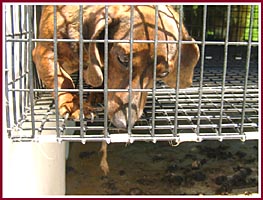 Ms Ribbens has been
to many, as well as the Thorp Dog Auction. She says, "I am always shocked
by the way people can treat animals and see absolutely 'nothing wrong with
it.'" Ms Ribbens has been
to many, as well as the Thorp Dog Auction. She says, "I am always shocked
by the way people can treat animals and see absolutely 'nothing wrong with
it.'"
For first-hand
descriptions of Wisconsin puppy mills, please see:
3. In your opinion, has this issue grown or
shrank in the past 10 years?
In Wisconsin, the
problem had definitely grown, because until 2011, we had no regulation of
breeding facilities and very weak humane laws. (see Existing Laws; there is also a link to Wisconsin
Chapter 951: Crimes Against Animals). However, this
situation is changing and will change further as the new Dog Seller Law is
enforced. Many commercial breeders are already opting to go out of business
rathar than comply with inspection and licensing.
You can read more about Wisconsin's new regulations here.
Puppymillers appear
to be moving their operations into unregulated states from Wisconsin and from
other states that are working on or have passed stricter regulation.
4. How many puppy mills have you witnessed being
shut down in Wisconsin, if any?
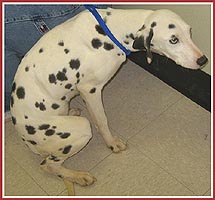 Just a few, so far.
However, we expect to see many more as the new law is enforced. Just a few, so far.
However, we expect to see many more as the new law is enforced.
In states with no
regulation, in order to shut one down there needs to be evidence of lack of
food, water and shelter, meaning a violation of minimum animal laws. Most of
the puppy millers provide these bare essentials because they know they cannot
be prosecuted if they provide these basics.
What conditions will
get a puppy miller put into jail actually depends a lot on the humane laws of
the state involved. Some states make it easier to arrest and convict mill
owners because they spell out exactly what is considered "adequate"
food, shelter, and care.
I've seen it stated
many times that arrests aren't made until animals are dying. However, with more
attention being given to puppymills now, people are reporting puppymillers
sooner, more priority is being given to investigating the complaints, and more
puppymillers are being arrested. Before the new Wisconsin law went into effect,
one Wisconsin puppymill was shut down by the health department because the
cages were so crowded and filthy!
For articles on the
closing of some Wisconsin puppy mills, please see:
|
| |
Top
|
| |
 Puppy Mill Laws Puppy Mill Laws
1. Does Wisconsin have ANY laws pertaining to
puppy mills as of right now?
 YES!!! On 1 December
2009, our 12-year-long dream came true, as, with his signature, Governor Doyle
turned AB-250, the Dog Breeders Licensure Bill, into the ground-breaking
Commercial Dog Breeders Licensure Law, now known as Wisconsin Act
90. YES!!! On 1 December
2009, our 12-year-long dream came true, as, with his signature, Governor Doyle
turned AB-250, the Dog Breeders Licensure Bill, into the ground-breaking
Commercial Dog Breeders Licensure Law, now known as Wisconsin Act
90.
That was just the
first step -- throughout 2010 and the beginning of 2011, the Wisconsin Puppy
Mill Project was instrumental in formulating and gathering public support for
ATCP 16, the Administrative Rules to enforce the new law.
Act
90/ATCP 16 went into effect on 1 June 2011.
2. Have any laws changed, or become stricter, in
Wisconsin in the last 5-10 years?
Please see above
paragraphs in red!
You can read more about Wisconsin's new regulations here.
Previous to that, a
law was enacted in 2001 relating to the licensing of pet breeders, pet dealers,
kennels, and animal shelters. This provision, also known as the “puppy
mills” law, was scheduled to take effect February 1, 2004. However, all
provision for funding was taken out by line-item veto. The law was repealed due
to lack of funding. (For details of this law, please see:
Legislative Brief: History of
the PFL (PDF)) This turned out to be a blessing in disguise, because Act 90
is a much better and stronger law!
3. What is the punishment for running a puppy
mill?
Punishments
depend on the laws of the state (or whether or not the breeder is
USDA-licensed). In most states, complaints about conditions at a commercial
breeder are investigated by local law enforcement. In some cases, a Humane
Officer is also consulted to decide whether conditions fall under the
anti-cruelty laws already in place. Some police officers are very careful about
trying to help animals in bad conditions; some see these calls as a waste of
their time. If the animals are in really terrible shape, a warrant can be
served and the animals taken away. The owners may pay a fine or go to jail,
depending, again, on the state and local laws.
If the
breeder is USDA-licensed, the USDA will investigate. If they find violations of
their standards, they will give the breeder a chance to "fix" them.
If the breeder doesn't fix the violations within a certain amount of time, he
can be fined, or lose his USDA license. Again, if the animals are in immediate
danger, or there are dead or dying animals on the premises, the inspector can
call in law enforcement to confiscate them. I believe that any legal action
must still go through the local law enforcement, but you might want to check
that out with the USDA (http://www.aphis.usda.gov/animal_welfare/awa_info.shtml;
there is a Contact link, and I've always found the folks there to be very good
about answering questions.)
The ASPCA
has a very good web page that will help you to find out the laws in your state
and who enforces them. Please see:
ASPCA Advocacy
Center State Animal Laws. You might also ask the police or the prosecutor's
office in your area how animal abuse complaints are handled.
4. Why aren't there stricter
national laws regarding puppy mills?
That's a very good
question, and one which you might address to your representatives to Congress!
Perhaps you might call them and talk to their staff members to see why this
issue has not been fully addressed on the national level. We enthusiastically
support stronger federal laws.
As mentioned before,
there are basically two different types of puppy mills: those who sell
wholesale to pet stores or laboratories, and those who sell directly to the
public through classified ads, over the internet, at flea markets, etc.
The breeders who sell
wholesale to pet stores must be licensed by the United States Department of
Agriculture (USDA). The USDA does have minimum standards that the puppy farmers
are supposed to meet. Unfortunately, they currently are funded for just over
100 inspectors for an estimated 9.000 licenced facilities.
You can read more about the USDA Animal
Welfare Act (AWA) here.
On this page, you
will also find links to the USDA website if you would like to read the AWA in
its entirety, and a link to the lists of license holders, by category and
state. You might also be interested in reading
Animal Welfare Regulations, "PART 3 -- STANDARDS,
Subpart A -- Specifications for the Humane Handling, Care, Treatment, and
Transportation of Dogs and Cats," which you'll find links to midway down
the page.
 By far, the largest
number of puppymillers --estimated to be in the thousands -- do NOT sell
puppies to pet stores. They sell directly to the public at swap meets, through
ads in the newspapers, over the internet, out of their cars in shopping plaza
parking lots, directly from their farms or homes, etc. In most states,
there is absolutely NO regulation, licensing, or inpection required. By far, the largest
number of puppymillers --estimated to be in the thousands -- do NOT sell
puppies to pet stores. They sell directly to the public at swap meets, through
ads in the newspapers, over the internet, out of their cars in shopping plaza
parking lots, directly from their farms or homes, etc. In most states,
there is absolutely NO regulation, licensing, or inpection required.
Some other states do
have good laws.
To read about the standards of care required by Colorado,
Pennsylvania, and Nevada, please click here.
Recently, legislation was introduced
on the federal level to "close the loophole" by requiring anyone who
sells more than 50 puppies a year by any method to be licensed by the USDA.
This legislation was called the Puppy Uniform Protection Statute.
Unfortunately, this bill was not made into law. If it had been, it would have
been very difficult to enforce without also increasing funding so that the USDA
could hire more people to do inspections and follow up on complaints.
Due to the hundreds
of bills introduced every session, this process can literally take years, with
the bill having to be reintroduced in every new session of Congress. And, of
course, there is some very stiff opposition from the pet industry lobbies.
To give you some
understanding of the legislative process, please
How a Bill Becomes a Law on the ASPCA website.
To read about the standards of care required by Colorado,
Pennsylvania, and Nevada, please click here.
What are the laws in your state, and who is in charge of
enforcing them?
|
| |
Top
|
| |
 Ending Puppy Mills Ending Puppy Mills
1. Are puppy mills anywhere near coming to an
end?
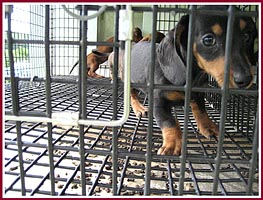 We can but hope. An
end to puppy mills comes closer every time a student like you writes a paper to
help educate people about puppy mills. The more people know about puppy mills,
the more they want to do something to help the puppies and the parent dogs. We can but hope. An
end to puppy mills comes closer every time a student like you writes a paper to
help educate people about puppy mills. The more people know about puppy mills,
the more they want to do something to help the puppies and the parent dogs.
We are also hoping
for better laws to put an end to puppy mills. However, it is very difficult
getting new laws passed.
3. Is there any way we can prevent puppy
mills?
The best thing people
can do to fight puppy mills is, NEVER buy a puppy at a petstore, from a
classified ad advertising several different types of dogs for sale, over the
internet, etc.! If nobody buys puppies from pet stores, then pet stores won't
buy so many puppies from puppymillers. If people don't buy puppies from
classified ads or over the internet or from a place with signs beside the road
-- it won't be profitable for the puppymillers to raise puppies any more.
Letting people know
about puppy mills is another major step toward ending them!
3. In your opinion, what is the best suggestion
one could give to a potential puppy buyer on buying a puppy?
We actually have two
suggestions:
NEVER buy a puppy at a petstore!
Do your homework before buying or adopting a pet. Be
sure you are ready to be responsible for a pet for its entire lifetime!
People should educate
themselves about the breed of dog they are interested in, and adopt from a
rescue or shelter -- or buy from a responsible breeder. We have several pages
on our website devoted to choosing a puppy:
4. What other organizations are out there that
are trying to prevent puppy mill success?
 I'm not quite clear
on what you mean by "prevent puppy mill success." If you mean, what
other organizations are trying to do away with puppymills, there are many,
including: Best Friends, Humane Society of the United States, ASPCA, PETA,
Hearts United For Animals, North Penn Puppy Mill Watch in Pennsylvania, Main
Line Animal Rescue (the one whose billboard got Oprah's attention) and many
many many other national organizations, shelters, rescues, and local
organizations. I'm not quite clear
on what you mean by "prevent puppy mill success." If you mean, what
other organizations are trying to do away with puppymills, there are many,
including: Best Friends, Humane Society of the United States, ASPCA, PETA,
Hearts United For Animals, North Penn Puppy Mill Watch in Pennsylvania, Main
Line Animal Rescue (the one whose billboard got Oprah's attention) and many
many many other national organizations, shelters, rescues, and local
organizations.
If you mean, what
other organizations are trying to block regulation of puppy mills -- that would
be breeders' associations, pet stores -- all those who raise and sell pets for
profit. For instance, in Wisconsin, a new organization has been started to
fight anti-puppymill legislation. It is called the Wisconsin Professional Pet
Breeders Association. Its president was, at the time of organization, the
largest "volume breeder" of dogs in Wisconsin, and the treasurer is
the owner of the only auction house in Wisconsin that sells dogs. Also, some
"hobby breeders" organizations are afraid that regulation of puppy
millers will affect them, and claim that any such regulation is against their
constitutional rights.
|
| |
Top
|
| |
 Getting the Word Out Getting the Word Out
1. Do you have any suggestions as to what may be
the most effective way to get the message out?
 There are many ways
to get the word out -- for instance, many pet store protests are being
scheduled in Wisconsin. Please see our Calendar
page for details. There are many ways
to get the word out -- for instance, many pet store protests are being
scheduled in Wisconsin. Please see our Calendar
page for details.
We also have
bumperstickers, window signs, and t-shirts available on our
Get the Word Out! page, as well as
downloadable and printable window signs, fact
sheets, posters, etc.
See our
What Can I Do? section for many more suggestions.
We also urge our
supporters to contact their state legislators and request regulation of
commercial pet breeding. It is vital that ALL residents of the state let their
elected officials know they SUPPORT such legislation. (Click here to
Find YOUR legislators.)
|
| |
Top
|
| |
 For
More Information: For
More Information:
|
| |
Top
|
| |
Home * Contact
Us * Site Map
What is a Puppy
Mill? * What YOU Can Do * Laws/Legislation * Action Alerts
Thorp Dog
Auctions * Puppy Mill Survivors * Photo Album
Guide to Finding a
Pet * Breeders With Pride * Drive To Save Lives!
©
Copyright, 2008. The Wisconsin Puppy MIll Project
P.O. Box 926 * Sheboygan, WI
53082-0926 * info@NoWisconsinPuppyMills.com
Article and Photos Copyright
© 2007, Kelly Beauparland. All Rights Reserved. Used with permission.
Website design by
Hook & Web
Designs
|









 They may be blind or have
legs missing; they may have genetic defects that are being passed along to the
puppies (such as heart murmurs, knee or hip problems, deafness, etc.). They
have rotten teeth and infected mouths from the poor food. They are never taken
out of the cages except to breed, and have none of the pleasant interaction
with humans that we take for granted with our own pets (such as being talked to
in an affectionate tone of voice, petted, played with, or exercised).
They may be blind or have
legs missing; they may have genetic defects that are being passed along to the
puppies (such as heart murmurs, knee or hip problems, deafness, etc.). They
have rotten teeth and infected mouths from the poor food. They are never taken
out of the cages except to breed, and have none of the pleasant interaction
with humans that we take for granted with our own pets (such as being talked to
in an affectionate tone of voice, petted, played with, or exercised). 





 Just a few, so far.
However, we expect to see many more as the new law is enforced.
Just a few, so far.
However, we expect to see many more as the new law is enforced.
 By far, the largest
number of puppymillers --estimated to be in the thousands -- do NOT sell
puppies to pet stores. They sell directly to the public at swap meets, through
ads in the newspapers, over the internet, out of their cars in shopping plaza
parking lots, directly from their farms or homes, etc. In most states,
there is absolutely NO regulation, licensing, or inpection required.
By far, the largest
number of puppymillers --estimated to be in the thousands -- do NOT sell
puppies to pet stores. They sell directly to the public at swap meets, through
ads in the newspapers, over the internet, out of their cars in shopping plaza
parking lots, directly from their farms or homes, etc. In most states,
there is absolutely NO regulation, licensing, or inpection required.


